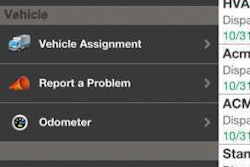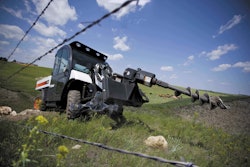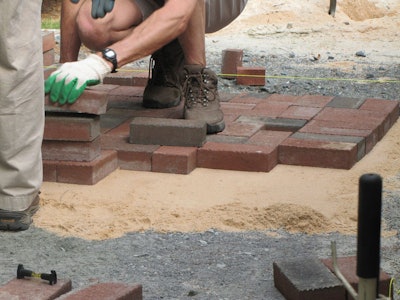 Photo: Pine Hall Brick
Photo: Pine Hall BrickPavers can be an integral part of many landscapes.
Whether incorporated into the floor, countertops or firepit, pavers serve a large purpose in the landscape industry, so it’s important to keep them healthy.
Solid foundation
Like many projects, creating a solid foundation is the key to creating a long life for pavers.
“Proper installation can ensure your patios will remain durable for a long time,” says Ken O’Neill, senior vice president of sales and marketing, Belgard Hardscapes.
Installers should consider the surface requirements such as avoid laying concrete pavers over an existing concrete surface. When placing pavers, drainage and spacing should be taken in to consideration.
Because pavers are part of a flexible pavement system, they will perform better with a proper base of aggregates placed and compacted per a design, O’Neill says.
A solid foundation is so crucial that the amount of maintenance could be significantly reduced because of it, says Walt Steele, paver business manager, Pine Hall Brick.
“I have found that the biggest key to a great paver project is paying attention to detail and installing the pavers according to Brick Industry Association (BIA) and Interlocking Concrete Pavement Institute (ICPI) specifications initially as a lot of maintenance tends to revolve around trying to fix installation issues and not with the pavers themselves,” Steele says.
A successful, long-lasting project can come from proper edge restraints, allowing adequate space between the pavers for joint sand and completely filling the joints with appropriate coarse sand, Steele adds.
Weathering the weather
Most pavers can hold up against even the toughest weather conditions, but landscapers need to be aware that certain preventative measures can damage pavers.
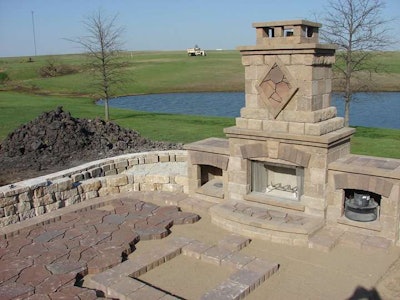 One of Sheller Lawn & Landscape’s projects shows the underlayment that is so critical to paver installation. Correctly installed pavers reduce the risk of damage later.
One of Sheller Lawn & Landscape’s projects shows the underlayment that is so critical to paver installation. Correctly installed pavers reduce the risk of damage later. Photo: Belgard Hardscapes
For concrete pavers, look for products that include colorfastness, weather resistance and durability.
Belgard Hardscapes uses Colorguard technology that disperses colors throughout the paver to resist UV rays, maintain color and hold up to weather extremes.
However, O’Neill says it’s important to be aware of the effects of deicing salts.
“While deicing salts can effectively eliminate slippery conditions, they also may adversely affect interlocking concrete pavers, often used in the landscape and walkways, by causing visual and structural damage,” O’Neill says. “Resistance to salts is related directly to a low absorption rate and a high compressive strength, and concrete pavers generally outperform solid concrete and asphalt in both areas.”
As for genuine clay pavers, Steele says they are completely unaffected by salt because they contain no cement.
However, deicers also can have a negative visual affect on clay pavers if landscapers are not careful.
“Deicers can, however, cause efflorescence, which is the white scum on the surface of the pavers caused by the salt drying on the surface of the pavers,” Steele says. “It then has to be flushed off of the pavers with water in the spring or removed with a specialty efflorescence removing product. It doesn’t affect the durability at all, but is unsightly.”
Deicers made from magnesium chloride do not affect the efflorescence but can be harmful to cement.
Because pavers do chip, Steele recommends using a rubber-tipped shovel or plow if removing snow to help reduce the possibility of chipping the edges of the pavers that are not flush.
What to avoid
Although pavers appear to be indestructible, landscapers should not be fooled.
Pavers can withstand a great deal of elements, but one false move, and a paver could be chipped permanently.
To avoid breaks and cracks, Steele says clay pavers should never be installed without sand between the joints or without enough sand between the joints.
“This will cause chipped edges and corners over time and the sand is what prevents the pavers from moving and the edges of the pavers from contacting each other,” Steele says.
Also, landscapers should make homeowners and property owners aware that if the pavers are going to be pressure washed, the nozzle needs to be far enough away from the edges of the pavers or the joint sand could be removed.
Repair as needed
If a paver has been damaged, all is not lost.
For clay pavers, installers should immediately check to make sure the joints between the pavers are filled with the sand and that the edge restraint is in good condition. If the pavers have shifted, move them back so the lines are straight and repair the edge restraint.
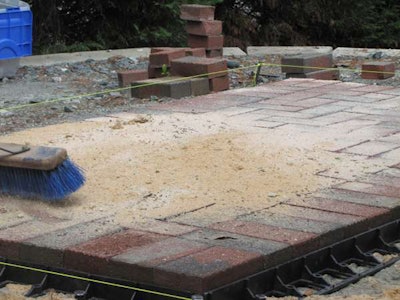 Photo: Pine Hall Brick
Photo: Pine Hall BrickFor chipped pavers, flip them over and repair broken pavers, as well as reapply joint sand to the entire system.
“Check your joints with a small flat-edge screw driver,” Steele says. “You should not be able to push it down into the joints at all. If you can, then the joint isn’t filled completely with sand.”
As for concrete pavers, O’Neill says single pavers can be removed and replaced with a new paver. He adds landscapers should educate homeowners and property owners on what do if a paver breaks or cracks.
Five key factors for pavers
1. Stay educated – In addition to continuing education courses that offer the latest in installation techniques, you can learn much from the manufacturers with whom you partner about installation tips that help ensure paver performance and the maintenance needed to maintain their life.
2. Choose quality products – choose products that are high quality and have a warranty to back up the claims; your reputation with your customers will be impacted by the durability of the products you install for them.
3. Seal its beauty – sealers are the perfect finishing touch to ensure that outdoor spaces look beautiful season after season and that you’ll have fewer return calls for repairs to recent projects. Periodically wash or sweep the surface to remove any collected dirt or food stains using a detergent such as dishwashing soap or cleaners designed for use on concrete pavers.
4. Continual care – advise your customers that in the event of winter weather, they should not over-apply salt; once inclement weather passes, remind them to wash off the pavers since the salt can continue to cause degradation even after the ice or snow has melted.
5. Rapid replacement – should a paver become chipped or cracked, work with the manufacturer to have it replaced ensuring your customers’ outdoor spaces remain safe and beautiful.
Five key factors for clay pavers
1. The most import maintenance tip is install it correctly the first time. 90 percent of maintenance is fixing problems caused by a poor installation.
2. Maintain full sand joints. If you notice that your sand joints are not completely full. Sweep some more sand into the joints.
3. You don’t need to stain or seal your clay pavers. It is an added expense that can only make clay pavers look worse.
4. Moss grows in wet areas that do not get any sunlight. You have to chance one of the two to completely fix the issue.
5. Use a coarse angular hard sand in the joints of the pavers. The easier the sand goes into the joints, the easier it will come out. The biggest problems are caused by lack of joint sand.
